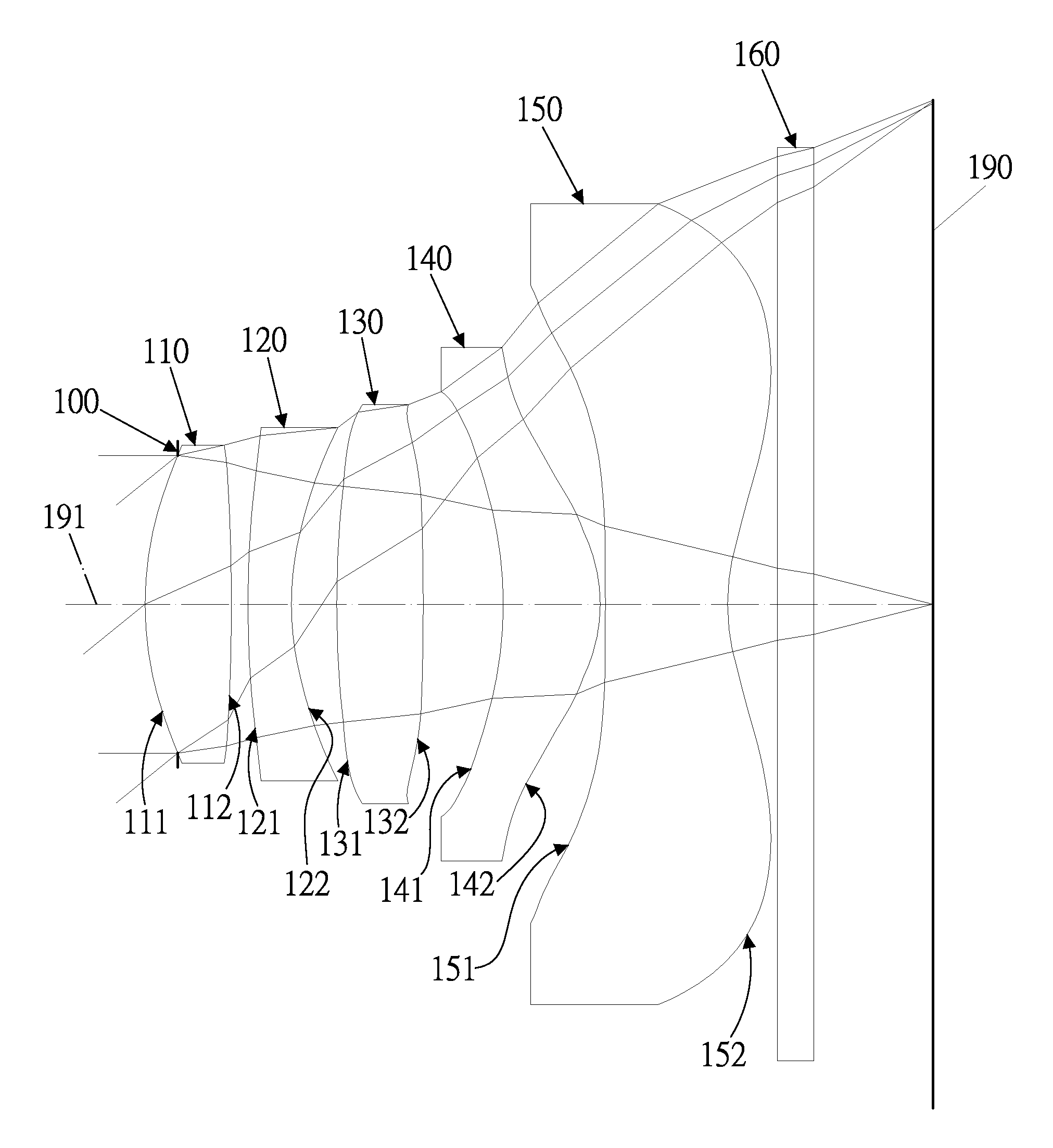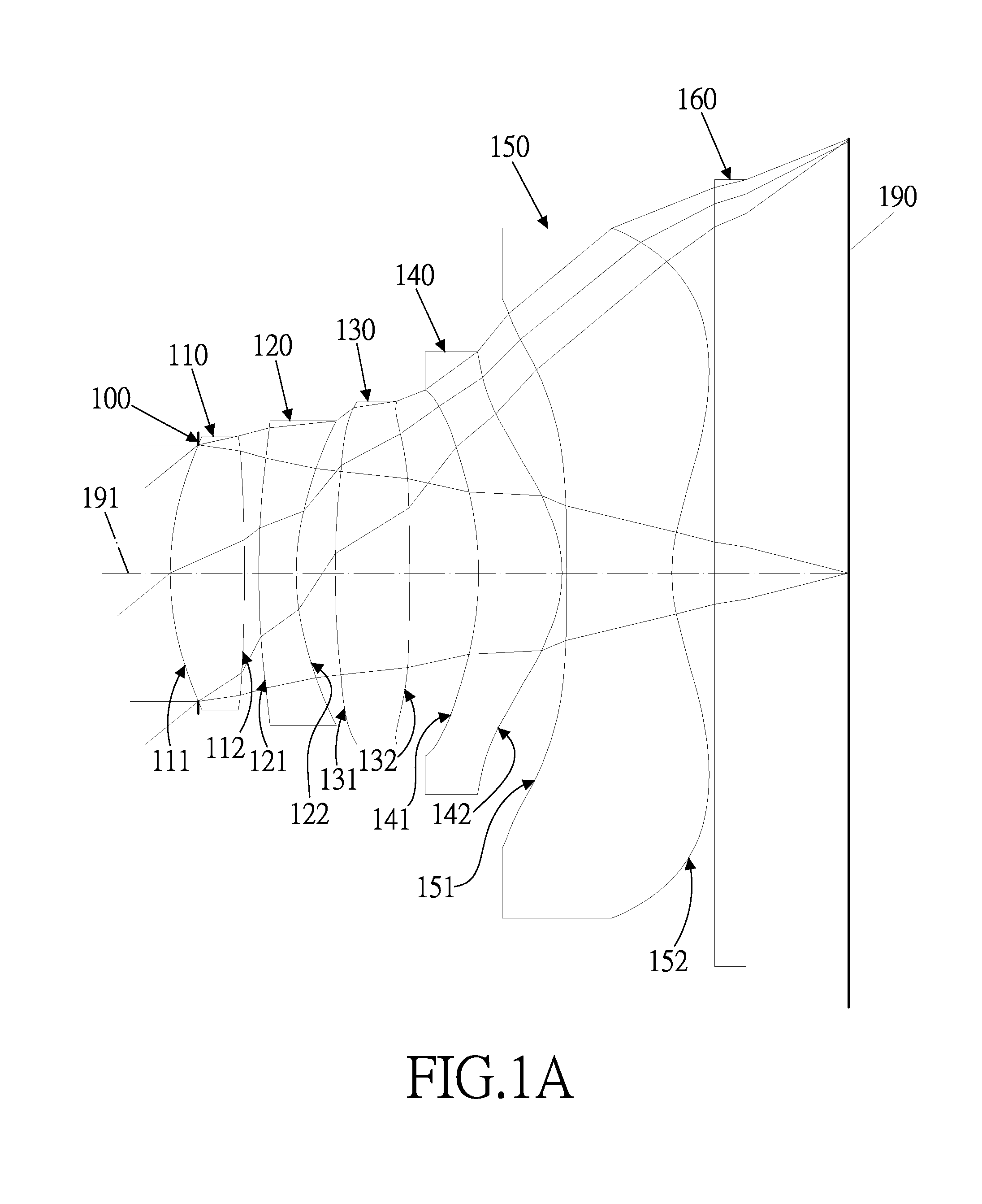Optical lens system
a technology of optical lens and optical lens frame, which is applied in the field of optical lens frame system, can solve the problems of poor image edge quality, high refractive material use, and increase manufacturing cos
- Summary
- Abstract
- Description
- Claims
- Application Information
AI Technical Summary
Benefits of technology
Problems solved by technology
Method used
Image
Examples
first embodiment
[0054]The equation for the aspheric surface profiles of the first embodiment is expressed as follows:
[0055]z(h)=ch21+1-(1+k)c2h2+A4h4+A6h6+A8h8+A10h10+A12h12+A14h14+⋯
[0056]z represents the distance of a point on the aspheric surface at a height h from the optical axis relative to a plane perpendicular to the optical axis at the vertex of the aspheric surface;
[0057]c is a paraxial curvature equal to 1 / R (R: a paraxial radius of curvature);
[0058]h represents a vertical distance from the point on the curve of the aspheric surface to the optical axis;
[0059]k represents the conic constant;[0060]A4, A6, Ag, A10, A12, A14 . . . : represent the high-order aspheric coefficients.
[0061]In the first embodiment of the present optical lens system, the focal length of the optical lens system is f, the f-number of the optical lens system is Fno, half of the maximum angle of field of view of the present optical lens system is HFOV, the maximum angle of field of view of the present optical ...
second embodiment
[0084]The equation for the aspheric surface profiles of the second embodiment is expressed as follows:
[0085]z(h)=ch21+1-(1+k)c2h2+A4h4+A6h6+A8h8+A10h10+A12h12+A14h14+⋯
[0086]z represents the distance of a point on the aspheric surface at a height h from the optical axis relative to a plane perpendicular to the optical axis at the vertex of the aspheric surface;
[0087]c is a paraxial curvature equal to 1 / R (R: a paraxial radius of curvature);
[0088]h represents a vertical distance from the point on the curve of the aspheric surface to the optical axis;
[0089]k represents the conic constant;[0090]A4, A6, Ag, A10, A12, A14 . . . : represent the high-order aspheric coefficients.
[0091]In the second embodiment of the present optical lens system, the focal length of the optical lens system is f, the f-number of the optical lens system is Fno, half of the maximum angle of field of view of the present optical lens system is HFOV, the maximum angle of field of view of the present optica...
third embodiment
[0114]The equation for the aspheric surface profiles of the third embodiment is expressed as follows:
[0115]z(h)=ch21+1-(1+k)c2h2+A4h4+A6h6+A8h8+A10h10+A12h12+A14h14+⋯
[0116]z represents the distance of a point on the aspheric surface at a height h from the optical axis relative to a plane perpendicular to the optical axis at the vertex of the aspheric surface;
[0117]c is a paraxial curvature equal to 1 / R (R: a paraxial radius of curvature);
[0118]h represents a vertical distance from the point on the curve of the aspheric surface to the optical axis;
[0119]k represents the conic constant;[0120]A4, A6, Ag, A10, A12, A14 . . . : represent the high-order aspheric coefficients.
[0121]In the third embodiment of the present optical lens system, the focal length of the optical lens system is f, the f-number of the optical lens system is Fno, half of the maximum angle of field of view of the present optical lens system is HFOV, the maximum angle of field of view of the present optical ...
PUM
 Login to View More
Login to View More Abstract
Description
Claims
Application Information
 Login to View More
Login to View More - R&D
- Intellectual Property
- Life Sciences
- Materials
- Tech Scout
- Unparalleled Data Quality
- Higher Quality Content
- 60% Fewer Hallucinations
Browse by: Latest US Patents, China's latest patents, Technical Efficacy Thesaurus, Application Domain, Technology Topic, Popular Technical Reports.
© 2025 PatSnap. All rights reserved.Legal|Privacy policy|Modern Slavery Act Transparency Statement|Sitemap|About US| Contact US: help@patsnap.com



